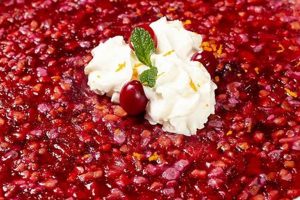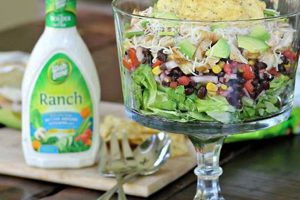A blend of finely ground cured ham, mayonnaise, and various seasonings creates a flavorful spread often served chilled on sandwiches, crackers, or as a filling for deviled eggs. Common additions include mustard, sweet pickle relish, hot sauce, and spices like paprika or cayenne pepper. Variations may incorporate hard-boiled eggs, onions, or celery for added texture and flavor complexity.
This easily prepared dish offers a convenient and economical way to utilize leftover ham, transforming it into a versatile spread suitable for casual meals, picnics, or potlucks. Its rich, savory profile makes it a popular choice for both appetizers and light lunches. The “deviled” designation refers to the spicy kick often imparted by ingredients like mustard and hot sauce, a culinary tradition dating back centuries.
The following sections will explore specific ingredient combinations, step-by-step preparation instructions, and creative serving suggestions to elevate this classic dish. From traditional recipes to contemporary interpretations, the versatility of this ham-based spread will be showcased for a variety of culinary preferences.
Tips for Crafting Exceptional Ham Salad
Optimizing flavor and texture requires attention to detail throughout preparation. The following tips offer guidance for creating a superior ham salad experience.
Tip 1: Ham Selection is Key: Utilizing high-quality, fully cooked ham significantly impacts the final result. Consider opting for a spiral-cut ham or leftover holiday ham for optimal flavor and texture.
Tip 2: Grind for Texture Control: Grinding the ham allows for even distribution and a smooth consistency. A food processor or meat grinder works well; alternatively, finely chopping the ham by hand provides a coarser texture.
Tip 3: Mayonnaise Matters: The quality and type of mayonnaise influence the overall richness and flavor profile. Experimenting with different brands or homemade mayonnaise allows for customized results.
Tip 4: Balancing the “Devil”: Achieving the desired level of spiciness requires careful consideration of ingredients like mustard, hot sauce, and spices. Start with small amounts and adjust according to preference.
Tip 5: Enhancing with Freshness: Incorporating finely diced celery, red onion, or fresh herbs like chives or parsley introduces textural contrast and bright, complementary flavors.
Tip 6: Chilling for Optimal Flavor: Allowing the ham salad to chill for at least 30 minutes before serving allows the flavors to meld and enhances the overall experience.
Tip 7: Creative Serving Options: Consider serving the ham salad on a variety of carriers beyond bread or crackers. Lettuce cups, hollowed-out tomatoes, or bell peppers offer fresh, visually appealing alternatives.
By focusing on ingredient quality and mindful preparation, one can elevate this simple dish to new heights. These tips offer a foundation for creating a flavorful and satisfying ham salad experience.
The following section will provide a collection of curated recipes showcasing the versatility of this classic dish.
1. High-quality Ham
The foundation of a successful deviled ham salad rests upon the quality of its central ingredient: ham. Selecting a high-quality ham significantly impacts the final flavor, texture, and overall enjoyment of the dish. This section explores the crucial role of ham selection within the broader context of deviled ham salad preparation.
- Flavor Profile:
Premium hams, often cured with natural ingredients and smoked slowly, possess a depth of flavor absent in commercially processed options. This inherent richness translates directly into the finished salad, creating a more complex and satisfying taste. A ham with a subtle smoky flavor, for example, can add another layer of complexity to the salad.
- Texture and Moisture:
High-quality hams tend to retain more moisture, resulting in a more tender and succulent salad. Conversely, dry or overly processed ham can lead to a dry, crumbly texture that detracts from the overall experience. A ham with good marbling will typically provide a more desirable texture in the final product.
- Salt Content:
The salt content in ham varies significantly. Premium hams often rely on less sodium, allowing for greater control over seasoning within the salad itself. This offers flexibility in balancing the other flavors, such as mustard and spices. Overly salty ham can limit this flexibility and overpower the other ingredients.
- Overall Quality Impact:
The quality of the ham directly influences the overall perception of the deviled ham salad. A superior ham elevates the dish from a simple spread to a truly enjoyable culinary experience. Using a high-quality ham allows the other ingredients to shine and contributes to a more balanced and nuanced final product.
Ultimately, investing in a high-quality ham ensures that the deviled ham salad achieves its full potential. The superior flavor, texture, and balanced salt content contribute significantly to a more satisfying and flavorful final product. This careful selection transforms a simple recipe into a culinary delight.
2. Precise Grinding
Precise grinding of ham plays a crucial role in determining the final texture and overall enjoyment of deviled ham salad. The degree of grinding influences how the ham interacts with other ingredients and affects the spread’s consistency. This seemingly minor detail significantly impacts the sensory experience of consuming the salad.
A coarse grind yields a chunkier texture, providing more distinct pieces of ham within the spread. This can be desirable for those who prefer a more substantial mouthfeel and a pronounced ham presence. Conversely, a fine grind creates a smoother, more homogenous texture, allowing the ham to blend seamlessly with the mayonnaise and seasonings. This results in a creamier consistency, ideal for spreading on crackers or using as a sandwich filling. For example, a coarsely ground deviled ham salad served on crusty bread offers a rustic experience, while a finely ground version used as a dip for vegetables provides a delicate contrast.
The choice of grinding method depends on individual preferences and the intended application of the deviled ham salad. Understanding the impact of grind size allows for greater control over the final product, enabling culinary customization and a more satisfying dining experience. Balancing the grind with other elements, such as the type of mayonnaise and the inclusion of other ingredients like pickles or onions, further refines the texture and overall quality of the deviled ham salad. Failure to consider grind size can result in a salad that is either too chunky and difficult to spread or too smooth and lacking in textural interest. Therefore, precise grinding is an essential step in achieving the desired texture and optimizing the enjoyment of deviled ham salad.
3. Balanced Seasonings
Balanced seasonings are essential for a successful deviled ham salad recipe. The “deviled” designation implies a certain level of spiciness, but this heat should be balanced with other complementary flavors to create a harmonious profile. The interplay of sweet, sour, salty, and spicy elements defines the character of the dish. For instance, the sharpness of mustard is often tempered by the sweetness of pickle relish, while a touch of cayenne pepper adds a warming heat without overpowering the other ingredients. Over-reliance on any single flavor can detract from the overall balance and diminish the complexity of the final product. A ham salad overly reliant on hot sauce, for example, might obscure the nuanced flavors of the ham and other seasonings.
Achieving this balance requires careful consideration of the chosen ingredients and their relative proportions. Common seasonings include mustard (yellow or Dijon), prepared horseradish, hot sauce, Worcestershire sauce, paprika, cayenne pepper, black pepper, and onion or garlic powder. The specific combination and quantity of these seasonings determine the final flavor profile. A classic deviled ham salad might employ a combination of yellow mustard, sweet pickle relish, and a dash of hot sauce for a balanced sweet, tangy, and spicy flavor. A more adventurous recipe might incorporate Dijon mustard, horseradish, and smoked paprika for a deeper, more complex flavor profile. Experimentation with different combinations and quantities is crucial for developing a signature recipe tailored to individual preferences.
Understanding the interplay of seasonings allows for precise control over the final flavor profile. This understanding extends beyond simply adding ingredients; it involves considering how each element interacts with the others to create a cohesive and balanced whole. The success of a deviled ham salad hinges on this delicate balance, transforming a simple mixture of ingredients into a flavorful and satisfying dish. Successfully balancing the seasonings in a deviled ham salad not only enhances its flavor but also allows for greater appreciation of the quality of the ham itself. A well-seasoned salad highlights the natural flavors of the ham without masking them with excessive spices or other dominant flavors. This balance is key to creating a deviled ham salad that is both flavorful and nuanced.
4. Mayonnaise Selection
Mayonnaise serves as the unifying element in deviled ham salad, binding the ground ham and seasonings into a cohesive spread. Its quality and characteristics significantly influence the final product’s texture, flavor, and overall appeal. Careful selection is crucial for achieving the desired outcome.
Different types of mayonnaise offer varying levels of richness, tanginess, and consistency. Standard mayonnaise provides a creamy texture and neutral flavor, serving as a blank canvas for the other ingredients. Full-fat mayonnaise contributes a richer mouthfeel, while reduced-fat options offer a lighter texture, potentially impacting the overall creaminess of the salad. Mayonnaise made with olive oil imparts a subtle fruity flavor, while some artisanal mayonnaises incorporate herbs or spices that may complement or clash with the other seasonings. For example, using a lemon-infused mayonnaise might enhance the brightness of a salad featuring dill and capers, but could clash with a spicier version relying on cayenne pepper and smoked paprika.
The quantity of mayonnaise also plays a vital role. Too little mayonnaise results in a dry, crumbly salad, whereas too much creates an overly loose consistency. The ideal amount depends on the desired texture and the ham’s moisture content. Achieving the proper balance ensures a spreadable consistency that holds its shape without being overly greasy. This balance contributes significantly to the overall enjoyment of the deviled ham salad, as it directly affects the ease of spreading and the perceived richness of the final product. Understanding the impact of mayonnaise selection empowers one to tailor the recipe to specific preferences and create a deviled ham salad that meets precise textural and flavor expectations.
5. Proper Chilling
Proper chilling is an essential step in preparing deviled ham salad, significantly impacting both its food safety and flavor profile. Chilling allows the flavors to meld and develop fully, resulting in a more cohesive and enjoyable culinary experience. Furthermore, adequate chilling is crucial for inhibiting bacterial growth and ensuring the salad’s safety for consumption.
- Flavor Enhancement:
Chilling allows the diverse flavors of the ham, mayonnaise, and seasonings to meld and harmonize. This fusion creates a more balanced and complex flavor profile compared to a freshly made, unchilled salad. The chilling process allows the individual components to lose their sharp edges and integrate into a unified whole, enhancing the overall gustatory experience.
- Texture Improvement:
Chilling firms the texture of the deviled ham salad, making it easier to spread on bread, crackers, or other carriers. The colder temperature solidifies the mayonnaise and allows the other ingredients to bind more effectively, preventing a runny or watery consistency. This improved texture enhances the salad’s presentation and ease of handling.
- Food Safety:
Proper chilling is crucial for preventing bacterial growth in deviled ham salad. Harmful bacteria can proliferate rapidly at room temperature, potentially leading to foodborne illness. Chilling inhibits this growth, ensuring the salad remains safe to consume. Adhering to recommended chilling times and temperatures mitigates this risk.
- Optimal Serving Temperature:
Deviled ham salad is best served chilled. The cooler temperature enhances its refreshing qualities, particularly in warmer weather. Serving the salad chilled also contributes to a more pleasant textural experience, avoiding a greasy or heavy mouthfeel that can occur at room temperature. The chilled temperature further complements the often spicy or tangy flavor profiles commonly found in deviled ham salads.
The benefits of proper chilling extend beyond mere convenience. Chilling plays a fundamental role in maximizing the flavor, optimizing the texture, and ensuring the safety of deviled ham salad. By allowing sufficient chilling time, the ingredients meld harmoniously, resulting in a more satisfying and safer culinary experience. This seemingly simple step elevates the dish from a basic mixture to a carefully crafted culinary creation.
6. Creative Serving
Creative serving elevates deviled ham salad from a simple dish to a memorable culinary experience. Presentation significantly impacts perceived value and enjoyment. Thoughtful consideration of serving vessels and accompaniments transforms the dish, adding visual appeal and enhancing flavor profiles. Moving beyond traditional bread or crackers opens avenues for innovative presentations tailored to various occasions, from casual gatherings to formal events. For instance, serving the salad in endive spears offers a light, refreshing alternative, while using miniature puff pastries creates a more elegant appetizer. These choices influence not only the aesthetic appeal but also the overall dining experience.
Strategic pairings further enhance the enjoyment of deviled ham salad. The salad’s inherent richness and often spicy profile allows for diverse complementary flavors and textures. Crisp vegetables, such as cucumber slices or bell pepper strips, provide a refreshing counterpoint to the richness of the ham and mayonnaise. Acidic elements, like pickled onions or cornichons, cut through the richness and add a tangy complexity. Serving the salad alongside crusty bread or crackers offers a textural contrast and a vehicle for convenient consumption. Consideration of these pairings demonstrates an attention to detail that elevates the dining experience. Serving deviled ham salad with a side of fruit salad, for example, offers a refreshing contrast, while pairing it with a selection of artisanal cheeses creates a more sophisticated presentation.
Creative serving offers an opportunity to showcase culinary ingenuity and enhance the overall enjoyment of deviled ham salad. Thoughtful presentation and strategic pairings elevate the dish beyond its basic components, transforming it into a more engaging and memorable experience. This approach demonstrates an understanding of the interplay between flavors, textures, and visual appeal, crucial for creating a truly satisfying dining experience. Successfully implementing creative serving techniques not only enhances the presentation of deviled ham salad but also adds depth and complexity to the overall culinary experience, making it more than just a simple dish but a considered creation.
Frequently Asked Questions
This section addresses common inquiries regarding deviled ham salad preparation and storage.
Question 1: What type of ham is best suited for deviled ham salad?
While various ham types suffice, leftover baked ham or spiral-cut ham generally offer superior flavor and texture. Canned ham can be used but may require adjustments to seasoning due to higher sodium content.
Question 2: How long can deviled ham salad be stored safely?
Properly stored in an airtight container in the refrigerator, deviled ham salad typically remains safe for consumption for three to five days. Discard any salad exhibiting signs of spoilage, such as an off odor or discoloration.
Question 3: Can deviled ham salad be frozen?
Freezing is not generally recommended. Mayonnaise-based salads often separate upon thawing, resulting in an undesirable texture. While freezing does not necessarily render the salad unsafe, it significantly impacts its quality.
Question 4: How can one adjust the spiciness of deviled ham salad?
Spiciness is easily adjusted by modifying the quantity of hot sauce, cayenne pepper, or other spicy ingredients. Start with small amounts and gradually increase until the desired level of heat is achieved. Taste-testing throughout the process is recommended.
Question 5: What are some suitable alternatives to mayonnaise in deviled ham salad?
Plain Greek yogurt or a mixture of Greek yogurt and mayonnaise offer healthier alternatives, reducing overall fat content while maintaining a creamy texture. Flavor adjustments may be necessary to compensate for the tanginess of yogurt.
Question 6: Can other ingredients be added to deviled ham salad?
Deviled ham salad welcomes additions like chopped celery, onion, pickles, hard-boiled eggs, or fresh herbs. These additions introduce textural and flavor complexity, allowing for customization to individual preferences.
Understanding these commonly addressed questions provides a solid foundation for successful deviled ham salad preparation and enjoyment. Careful consideration of ingredients, storage practices, and flavor adjustments ensures a satisfying culinary experience.
The following section offers a collection of curated deviled ham salad recipes, ranging from traditional preparations to contemporary variations.
Deviled Ham Salad Recipe
This exploration of deviled ham salad recipes has highlighted the critical elements contributing to a successful outcome. From the careful selection of high-quality ham to the precise balancing of seasonings, each step plays a vital role in the final product. The importance of proper grinding, mayonnaise selection, and chilling techniques were underscored for optimizing both texture and flavor. Furthermore, the potential for creative serving and ingredient variations allows for personalized interpretations of this classic dish, demonstrating its versatility.
Deviled ham salad, though seemingly simple, offers a canvas for culinary expression. Attention to detail and a thorough understanding of the interplay between ingredients elevates this dish beyond a mere combination of components. Exploration of diverse flavor profiles and presentation styles allows for continued evolution and enjoyment of this timeless recipe. The potential for creativity within this seemingly straightforward dish remains vast, inviting further culinary exploration and innovation.






